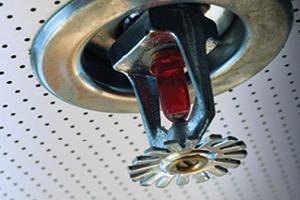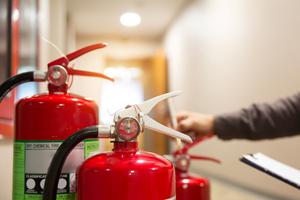Fluorescent and other mercury-containing lamps
Almost all fluorescent and high intensity discharge lamps contain small quantities of mercury. Because of the potential health hazard, mercury-containing lamps should be handled carefully. Special precautions should be taken if they are accidentally broken. Lamps should be disposed of according to state and local rules, preferably by recycling.
Types that may contain mercury
The following lamps may contain mercury or other substances requiring special handling and disposal:
- Fluorescent tubes, used in schools, offices, homes, commercial and manufacturing facilities
- Compact fluorescent bulbs, used in homes and businesses to replace less efficient incandescent light bulbs
- High intensity discharge lamps, including mercury, metal halide and sodium lamps typically used for outdoor security and street lighting, in arena floodlight and industrial lighting systems, and for medical treatment, industrial production, and water and air purification
Lamp disposal — best practices
Not all spent or broken lamps need to be disposed of as hazardous waste. That depends on the type of user, the state where the user is located and the amount of mercury inside.
A growing number of states have passed laws more stringent than federal, banning the disposal of all or most all mercury-containing lamps in solid waste. (Federal law exempts households and small quantity generators, and lamps with low mercury content.)
The National Electrical Manufacturers Association (NEMA) recommends contacting state authorities to determine local disposal requirements. NEMA also encourages businesses and consumers to voluntarily recycle their spent mercury-containing lamps.
Information on state requirements may be found at the NEMA-sponsored website www.lamprecycle.org. The site contains a list of recyclers. The site also has links to state websites with information about local rules concerning mercury-containing lamps.
Cleaning up broken lamps
Broken lamps may cause release of hazardous materials that can create potential health hazards.
When a lamp breaks a supervisor or manager should be notified immediately. Special training may be needed for those who perform cleanup. Those who are trained will likely do the following:
- Ventilate the area to disperse any vapors that may have been generated
- Keep people away to prevent powder or broken pieces from being tracked into other areas
- Use only vacuums designed for hazardous waste, not a standard vacuum or wet/dry shop vacuum
- Wear gloves and wipe the area with a damp paper towel
- Place materials in a sealed plastic bag or closed container; include any lamp that shows evidence of leakage or damage
- Don't touch hands to face. Wash hands thoroughly when done
Lamp replacement
Manufacturers' recommendations should be strictly followed when replacing lamps. Guidelines will likely include the following:
- Store and transport lamps in compatible packages and containers that are adequate to prevent breakage
- Keep containers and packages closed except when adding or removing lamps
- Watch for evidence of leaks or container damage; report any issues immediately to a supervisor or manager
- Never break any lamps
- Send used lamps to a hazardous waste recycling facility
Conclusion
Fluorescent and high intensity discharge lamps contain potentially hazardous materials including mercury. They should be handled with care. Lamps should not be broken on purpose. If a lamp is accidentally broken, cleanup should be performed by trained personnel. Some lamps with low mercury content may be disposed of as ordinary garbage. However, some states ban the disposal of mercury lamps in municipal waste. Lamp disposal should be according to local and state requirements, preferably at hazardous waste recycling facilities. State and local regulations should always be followed.
This material is provided for informational purposes only and does not provide any coverage or guarantee loss prevention. The examples in this material are provided as hypothetical and for illustration purposes only. The Hanover Insurance Company and its affiliates and subsidiaries (“The Hanover”) specifically disclaim any warranty or representation that acceptance of any recommendations contained herein will make any premises, or operation safe or in compliance with any law or regulation. By providing this information to you. The Hanover does not assume (and specifically disclaims) any duty, undertaking or responsibility to you. The decision to accept or implement any recommendation(s) or advice contained in this material must be made by you.
LC OCT 2018 14-65
171-0919 (1/14)
Related resources
Fluorescent and other mercury-containing lamps
Almost all fluorescent and high intensity discharge lamps contain small quantities of mercury. Because of the potential health hazard, mercury-containing lamps should be handled carefully. Special precautions should be taken if they are accidentally broken. Lamps should be disposed of according to state and local rules, preferably by recycling.
Types that may contain mercury
The following lamps may contain mercury or other substances requiring special handling and disposal:
- Fluorescent tubes, used in schools, offices, homes, commercial and manufacturing facilities
- Compact fluorescent bulbs, used in homes and businesses to replace less efficient incandescent light bulbs
- High intensity discharge lamps, including mercury, metal halide and sodium lamps typically used for outdoor security and street lighting, in arena floodlight and industrial lighting systems, and for medical treatment, industrial production, and water and air purification
Lamp disposal — best practices
Not all spent or broken lamps need to be disposed of as hazardous waste. That depends on the type of user, the state where the user is located and the amount of mercury inside.
A growing number of states have passed laws more stringent than federal, banning the disposal of all or most all mercury-containing lamps in solid waste. (Federal law exempts households and small quantity generators, and lamps with low mercury content.)
The National Electrical Manufacturers Association (NEMA) recommends contacting state authorities to determine local disposal requirements. NEMA also encourages businesses and consumers to voluntarily recycle their spent mercury-containing lamps.
Information on state requirements may be found at the NEMA-sponsored website www.lamprecycle.org. The site contains a list of recyclers. The site also has links to state websites with information about local rules concerning mercury-containing lamps.
Cleaning up broken lamps
Broken lamps may cause release of hazardous materials that can create potential health hazards.
When a lamp breaks a supervisor or manager should be notified immediately. Special training may be needed for those who perform cleanup. Those who are trained will likely do the following:
- Ventilate the area to disperse any vapors that may have been generated
- Keep people away to prevent powder or broken pieces from being tracked into other areas
- Use only vacuums designed for hazardous waste, not a standard vacuum or wet/dry shop vacuum
- Wear gloves and wipe the area with a damp paper towel
- Place materials in a sealed plastic bag or closed container; include any lamp that shows evidence of leakage or damage
- Don't touch hands to face. Wash hands thoroughly when done
Lamp replacement
Manufacturers' recommendations should be strictly followed when replacing lamps. Guidelines will likely include the following:
- Store and transport lamps in compatible packages and containers that are adequate to prevent breakage
- Keep containers and packages closed except when adding or removing lamps
- Watch for evidence of leaks or container damage; report any issues immediately to a supervisor or manager
- Never break any lamps
- Send used lamps to a hazardous waste recycling facility
Conclusion
Fluorescent and high intensity discharge lamps contain potentially hazardous materials including mercury. They should be handled with care. Lamps should not be broken on purpose. If a lamp is accidentally broken, cleanup should be performed by trained personnel. Some lamps with low mercury content may be disposed of as ordinary garbage. However, some states ban the disposal of mercury lamps in municipal waste. Lamp disposal should be according to local and state requirements, preferably at hazardous waste recycling facilities. State and local regulations should always be followed.
This material is provided for informational purposes only and does not provide any coverage or guarantee loss prevention. The examples in this material are provided as hypothetical and for illustration purposes only. The Hanover Insurance Company and its affiliates and subsidiaries (“The Hanover”) specifically disclaim any warranty or representation that acceptance of any recommendations contained herein will make any premises, or operation safe or in compliance with any law or regulation. By providing this information to you. The Hanover does not assume (and specifically disclaims) any duty, undertaking or responsibility to you. The decision to accept or implement any recommendation(s) or advice contained in this material must be made by you.
LC OCT 2018 14-65
171-0919 (1/14)
Related resources
Fluorescent and other mercury-containing lamps
Almost all fluorescent and high intensity discharge lamps contain small quantities of mercury. Because of the potential health hazard, mercury-containing lamps should be handled carefully. Special precautions should be taken if they are accidentally broken. Lamps should be disposed of according to state and local rules, preferably by recycling.
Types that may contain mercury
The following lamps may contain mercury or other substances requiring special handling and disposal:
- Fluorescent tubes, used in schools, offices, homes, commercial and manufacturing facilities
- Compact fluorescent bulbs, used in homes and businesses to replace less efficient incandescent light bulbs
- High intensity discharge lamps, including mercury, metal halide and sodium lamps typically used for outdoor security and street lighting, in arena floodlight and industrial lighting systems, and for medical treatment, industrial production, and water and air purification
Lamp disposal — best practices
Not all spent or broken lamps need to be disposed of as hazardous waste. That depends on the type of user, the state where the user is located and the amount of mercury inside.
A growing number of states have passed laws more stringent than federal, banning the disposal of all or most all mercury-containing lamps in solid waste. (Federal law exempts households and small quantity generators, and lamps with low mercury content.)
The National Electrical Manufacturers Association (NEMA) recommends contacting state authorities to determine local disposal requirements. NEMA also encourages businesses and consumers to voluntarily recycle their spent mercury-containing lamps.
Information on state requirements may be found at the NEMA-sponsored website www.lamprecycle.org. The site contains a list of recyclers. The site also has links to state websites with information about local rules concerning mercury-containing lamps.
Cleaning up broken lamps
Broken lamps may cause release of hazardous materials that can create potential health hazards.
When a lamp breaks a supervisor or manager should be notified immediately. Special training may be needed for those who perform cleanup. Those who are trained will likely do the following:
- Ventilate the area to disperse any vapors that may have been generated
- Keep people away to prevent powder or broken pieces from being tracked into other areas
- Use only vacuums designed for hazardous waste, not a standard vacuum or wet/dry shop vacuum
- Wear gloves and wipe the area with a damp paper towel
- Place materials in a sealed plastic bag or closed container; include any lamp that shows evidence of leakage or damage
- Don't touch hands to face. Wash hands thoroughly when done
Lamp replacement
Manufacturers' recommendations should be strictly followed when replacing lamps. Guidelines will likely include the following:
- Store and transport lamps in compatible packages and containers that are adequate to prevent breakage
- Keep containers and packages closed except when adding or removing lamps
- Watch for evidence of leaks or container damage; report any issues immediately to a supervisor or manager
- Never break any lamps
- Send used lamps to a hazardous waste recycling facility
Conclusion
Fluorescent and high intensity discharge lamps contain potentially hazardous materials including mercury. They should be handled with care. Lamps should not be broken on purpose. If a lamp is accidentally broken, cleanup should be performed by trained personnel. Some lamps with low mercury content may be disposed of as ordinary garbage. However, some states ban the disposal of mercury lamps in municipal waste. Lamp disposal should be according to local and state requirements, preferably at hazardous waste recycling facilities. State and local regulations should always be followed.
This material is provided for informational purposes only and does not provide any coverage or guarantee loss prevention. The examples in this material are provided as hypothetical and for illustration purposes only. The Hanover Insurance Company and its affiliates and subsidiaries (“The Hanover”) specifically disclaim any warranty or representation that acceptance of any recommendations contained herein will make any premises, or operation safe or in compliance with any law or regulation. By providing this information to you. The Hanover does not assume (and specifically disclaims) any duty, undertaking or responsibility to you. The decision to accept or implement any recommendation(s) or advice contained in this material must be made by you.
LC OCT 2018 14-65
171-0919 (1/14)
Related resources
Fluorescent and other mercury-containing lamps
Almost all fluorescent and high intensity discharge lamps contain small quantities of mercury. Because of the potential health hazard, mercury-containing lamps should be handled carefully. Special precautions should be taken if they are accidentally broken. Lamps should be disposed of according to state and local rules, preferably by recycling.
Types that may contain mercury
The following lamps may contain mercury or other substances requiring special handling and disposal:
- Fluorescent tubes, used in schools, offices, homes, commercial and manufacturing facilities
- Compact fluorescent bulbs, used in homes and businesses to replace less efficient incandescent light bulbs
- High intensity discharge lamps, including mercury, metal halide and sodium lamps typically used for outdoor security and street lighting, in arena floodlight and industrial lighting systems, and for medical treatment, industrial production, and water and air purification
Lamp disposal — best practices
Not all spent or broken lamps need to be disposed of as hazardous waste. That depends on the type of user, the state where the user is located and the amount of mercury inside.
A growing number of states have passed laws more stringent than federal, banning the disposal of all or most all mercury-containing lamps in solid waste. (Federal law exempts households and small quantity generators, and lamps with low mercury content.)
The National Electrical Manufacturers Association (NEMA) recommends contacting state authorities to determine local disposal requirements. NEMA also encourages businesses and consumers to voluntarily recycle their spent mercury-containing lamps.
Information on state requirements may be found at the NEMA-sponsored website www.lamprecycle.org. The site contains a list of recyclers. The site also has links to state websites with information about local rules concerning mercury-containing lamps.
Cleaning up broken lamps
Broken lamps may cause release of hazardous materials that can create potential health hazards.
When a lamp breaks a supervisor or manager should be notified immediately. Special training may be needed for those who perform cleanup. Those who are trained will likely do the following:
- Ventilate the area to disperse any vapors that may have been generated
- Keep people away to prevent powder or broken pieces from being tracked into other areas
- Use only vacuums designed for hazardous waste, not a standard vacuum or wet/dry shop vacuum
- Wear gloves and wipe the area with a damp paper towel
- Place materials in a sealed plastic bag or closed container; include any lamp that shows evidence of leakage or damage
- Don't touch hands to face. Wash hands thoroughly when done
Lamp replacement
Manufacturers' recommendations should be strictly followed when replacing lamps. Guidelines will likely include the following:
- Store and transport lamps in compatible packages and containers that are adequate to prevent breakage
- Keep containers and packages closed except when adding or removing lamps
- Watch for evidence of leaks or container damage; report any issues immediately to a supervisor or manager
- Never break any lamps
- Send used lamps to a hazardous waste recycling facility
Conclusion
Fluorescent and high intensity discharge lamps contain potentially hazardous materials including mercury. They should be handled with care. Lamps should not be broken on purpose. If a lamp is accidentally broken, cleanup should be performed by trained personnel. Some lamps with low mercury content may be disposed of as ordinary garbage. However, some states ban the disposal of mercury lamps in municipal waste. Lamp disposal should be according to local and state requirements, preferably at hazardous waste recycling facilities. State and local regulations should always be followed.
This material is provided for informational purposes only and does not provide any coverage or guarantee loss prevention. The examples in this material are provided as hypothetical and for illustration purposes only. The Hanover Insurance Company and its affiliates and subsidiaries (“The Hanover”) specifically disclaim any warranty or representation that acceptance of any recommendations contained herein will make any premises, or operation safe or in compliance with any law or regulation. By providing this information to you. The Hanover does not assume (and specifically disclaims) any duty, undertaking or responsibility to you. The decision to accept or implement any recommendation(s) or advice contained in this material must be made by you.
LC OCT 2018 14-65
171-0919 (1/14)





